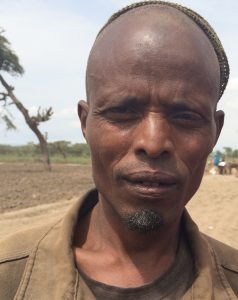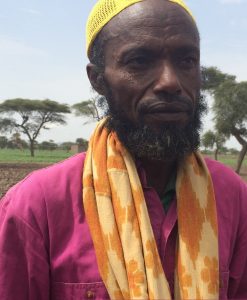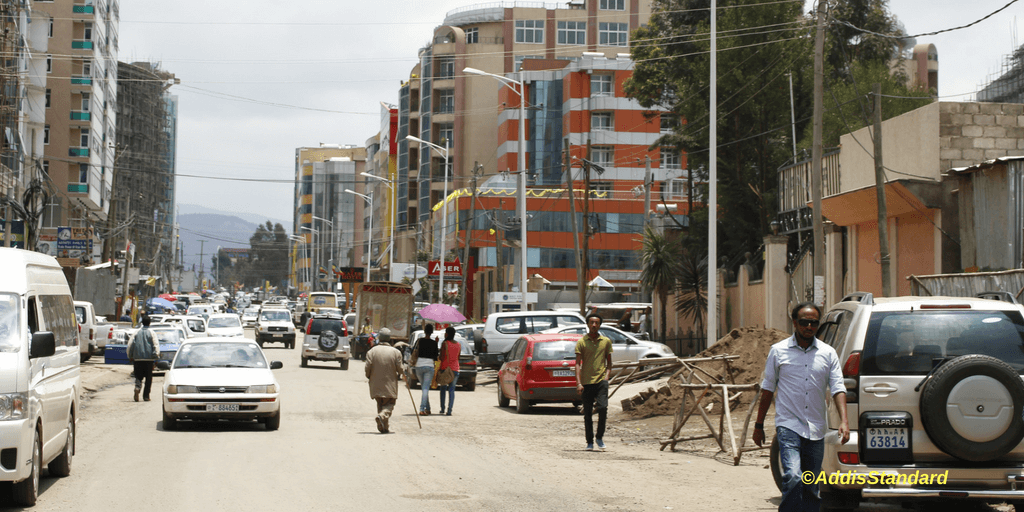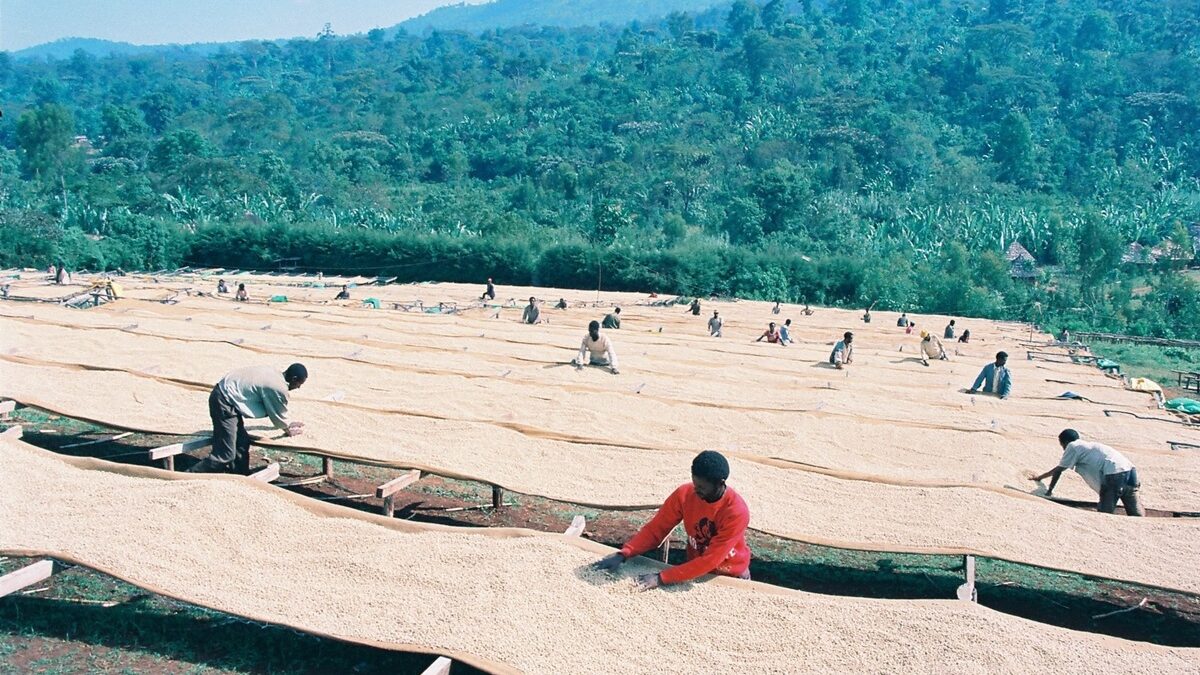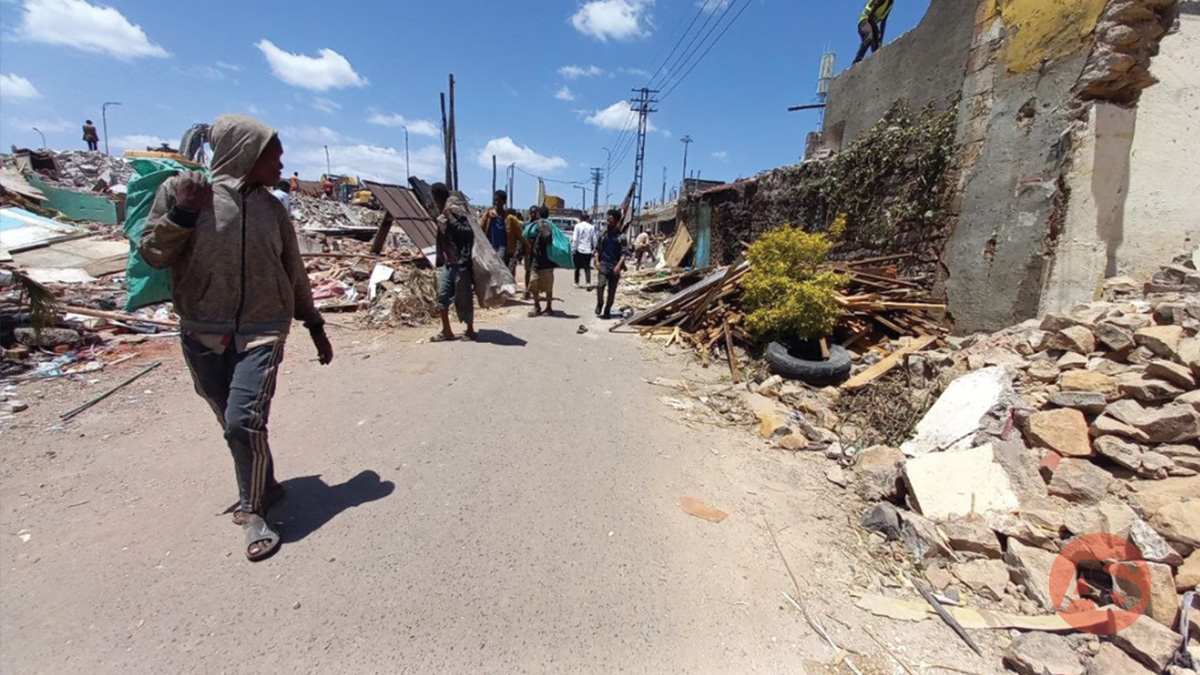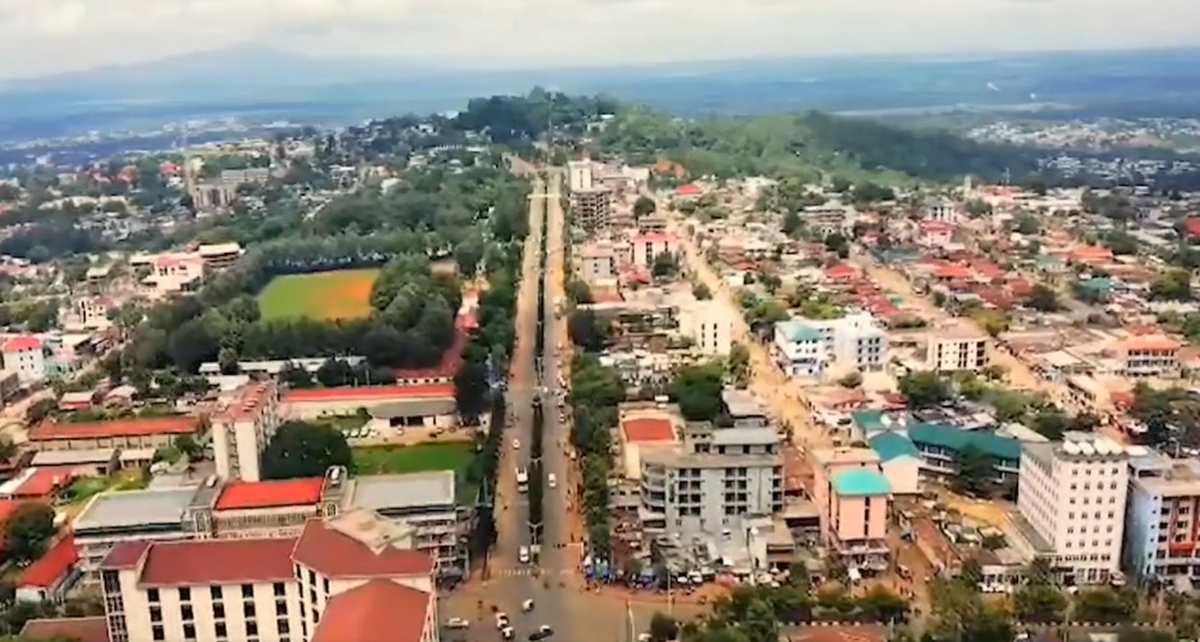Tesfalem Waldyes & Kalkidan Yibeltal
On June 28 2016, hundreds of people in Jido Kombolocha, a small town located in East Shoa Zone of the Oromia regional state 207 km south east of Addis Abeba, were heading towards the local Farmers’ Cooperatives Union office. Even though it was Tuesday, the air was full of a market day ambiance – market days for the farmers in the surrounding rural Kebeles are usually on Monday and Thursday. Many of the farmers used carts pulled by donkeys, while others used their horses. A few, on the other hand, preferred to walk. At their destination, a crowd of people had already gathered, flooding the Union’s compound that accommodated tin-roofed houses.
The local administration uses the compound, which harbors sacks of grains and cereals piled on three separate spots, as a relief food distribution center. Residents that came from the surrounding rural Kebeles were lining up to collect food aid that was being distributed. The sacks, which the farmers were loading on their carts or sitting on, visibly display the national flag and a statement that reads: “Gift from the Government of Ethiopia.”
Milling wheat, white pea beans, cereals and edible oil were the main items given to the rural residents of Adami Tulu/ Jido/Kombolocha Woreda on that day. But the distribution targeted only three of the 43 rural Kebeles in the Woreda. Home to some 172,000 people, the Woreda is designated as one of the hot spot areas of the recent El-Nino induced drought that affected more than 10.2 million people all over the country.
For inhabitants of the area, drought related rain shortages are not uncommon. Living in an area prone to water scarcity, the local farmers chiefly depend on the main rainy season, spanning from June to September, for the cultivation of their produces. Thus, whenever a rainy season botches, thousands are immediately relegated to the status of food aid recipients.
Nonetheless, the reality of the past two years was nothing like they had seen thus far.
“On previous occurrences only four to five Kebeles were affected. The number of food aid beneficiaries [normally] fall between five to ten thousand,” Abiti Kemele, Head of the Woreda’s Disaster Prevention and Preparedness Bureau, told Addis Standard. “Now all the 43 rural kebeles are affected. The number of beneficiaries is huge. Almost 70 to 80 per cent of the population is [living] on food aid.”
What makes the recent drought especially worse is that it affected not only farmers considered to be vulnerable to external shocks but also those who are included in the much publicized (and admired) social security system, otherwise known as the Productive Safety Net Program (PSNP). It is a program that was designed (and is being implemented) to respond to not only chronic food insecurity problems but also short term environmental shocks, and help millions of people under its umbrella become sustainably self-reliant.
Targeting highly climate-vulnerable population, PSNP is a double-pronged program that aspires to provide social protection to the chronically food insecure and shield the poorest of the poor in the rural areas from environmental shocks, while simultaneously reducing the risk of disaster by building up the capacity for resilience.
The program, which began in 2005, often receives applauds, both from the federal government, which is in charge of running it, and its Western development partners, which are helping to finance it; both parties maintain the narrative that PSNP is a package that bridges the response gap between emergency relief and long-term development aid.
However, more than a decade after it first came into being and a year into its fourth phase, which extends to 2020, PSNP appears to have fallen short on some of its significant promises and aspirations. (Read our economic commentary here).
Decent proposal, modest effects
Plans for the PSNP, commonly known as “Safety Net,” were first laid in 2003, but the actual implementation was launched only two years later when the government started providing food or cash transfers to food insecure households – households that had been on food aid assistance for at least three previous years. Aimed at preventing asset depletion in household level and creating productive assets at the community level, the PSNP, according to official documents, incorporates intensive public work activities to improve resilience, risk financing facility to help poor households to better cope with transitory shocks, and assisting the most vulnerable community members to obtain the full benefits of consumption smoothing and asset protection.
At the onset of its implementation, only four regions; Tigray, Amhara, Oromia and the Southern Nations, Nationalities and Peoples Region (SNNP) were included. But in the decade since its birth, it grew and now covers eight regions.
Theoretically PSNP is a program designed to engage its beneficiaries in labor intensive public works, 60 per cent of which are in soil and water conservation. In order to fill the food gap often experienced during a lean period – the time between harvest and planting when households tend to run out of food – cash is paid for up to five days of work a month per household member. This cash-for-work project goes for six months a year, until recipient households accumulate an asset and income level that enables them meet their food needs for 12 months, and until they are able to withstand modest shocks at which time they ‘graduate’ from the program.
In the ‘direct support’ component of the program, on the other hand, groups that cannot contribute labor to public works are offered unconditional cash or food of equivalent value to that received by labor contributing households. Pregnant and lactating mothers, the elderly, persons with disabilities and the chronically ill are some of the beneficiaries of direct support.
However, a 2011 PSNP impact evaluation study found out that households receiving Direct Support had considerably lower average income and asset values, and owned and cultivated less land than households participating in the Public Works component.
And a study conducted by Guush Berhane et al. of the International Food Policy Research Institute (IFPRI), Can Social Protection Work in Africa? The Impact of Ethiopia’s Social Protection Program, found out, “[a]gainst the formidable background of rising food prices and widespread drought, participation in the Public Works component of the PSNP has modest effects.”
To its credit, the program reduced the length of the last hungry season by 1.29 months a year among households that received transfers for 5 consecutive years compared to eligible households that received almost nothing. Meanwhile five years of participation raises livestock holdings by 0.38 tropical livestock units as compared to receipt of payments for just one year.
During the 2011 Horn of Africa food crisis, the PSNP response had cost an estimated US$53 per beneficiary compared to US$169 per beneficiary targeted through the usual traditional humanitarian response system, according to a report published by the UK’s House of Commons International Development Committee.
In its fourth phase now, the PSNP targets to reach 10 million food insecure Ethiopians by 2017. According to the blueprint document for Phase Four, which commenced in September 2014, the program is expected to cover a total of 411 Woredas by the third year, showing an increase of 92 Woredas compared to PSNP phase three.
Perpetual state of poverty
Adami Tulu/ Jido/ KombolochaWoreda is one of the 262 food insecure Woredas when PSNP was launched in 2005. But the Woreda remained in the beneficiary list for the last 11 years. The household of Ahmed Haji Kedir, 55, is one of the registered 23,000 beneficiaries of the program.
Ahmed mainly relies on the Safety Net to feed his eight children, himself and his wife. He receives 730 Birr per month on behalf of five of his eight children. His other three children, his wife and himself are excluded from the program. Ahmed complained that the amount his household receives is not enough to buy food for the family, let alone cover other expenses. “A quintal of maize now costs 700 Birr,” Ahmed told Addis Standard. “We are left with 30 Birr after we bought maize. It is only enough to buy some Kale (cabbage).”
Like the 8,000 inhabitants in his village, Dambe Adansho Kebele, Ahmed is severely affected by the failure of rain in the last two years. For six months of a year, he and his family survived through the Safety Net’s support but for the remaining months, his family totally depends on his daily labor work.
Despite being a recipient of the Safety Net program since its inception, Ahmed is not able to recover his plot of land which he sold years back to sustain his family. He is also not able to build an asset during his 11 years stay in the program. “I don’t have land,” Ahmed said, “I am not able to get out of poverty.”
Ahmed Haji relies on the Saftey Net to feed his family of ten
It’s the struggling beneficiaries like Ahmed that trigger a question of the effectiveness of the PSNP. A document by the World Bank states that the program is embedded in the Ethiopian government’s strategy and policy of food security and eradication of extreme poverty. The Bank, which is one of the 11 co-financers of the PSNP, considers the program as a direct contributor to the “two pillars of the organization’s new global strategy of reducing absolute poverty and promoting shared prosperity.”
However, what Addis Standard observed on the ground is in line with what critics of the program point out. On his research, Food Security and Safety Nets: Assessment and Challenges, Desalegn Rahmato of Forum for Social Studies, argues that although the program had a “positive impact on many beneficiaries, the gains made so far have not been adequate enough to ensure robust food security for most households.”
Others indicate at the ever ballooning cost of the program as yet another gauge to question whether or not the program has met its target of reducing poverty amongst millions of its beneficiaries. Several indicators show that the financing of the project is registering a significant increase with every phase rather than declining.
For the first phase of PSNP, 2005 to 2006, donors have contributed US$70 million. That amount almost tripled to US$200 million for the second phase that ran from 2007 to 2009. The five year long third phase, which started in 2010 and ended in 2015, consumed US$2.3 billion. When it reached to the current phase the figure has sky rocketed to US$3.6 billion.
As the budget keeps on growing, so does the number of beneficiaries, which was 5.2 million at the program launch in 2005. It quickly climbed to 7.2 million just after a year. On the second and third phases, the numbers have increased to 7.6 million and 8.3 million, respectively. The current phase, PSNP Four, which is being implemented for a period of five and a half years as of September 2014, targets to benefit as high as 10 million people.
As of September 2016, an urban safety net program will also start operating in Addis Abeba, the government said a few weeks ago. The program is expected to assist more than 260 000 beneficiaries, of whom 60 000 will be recipients of Direct Support for the coming ten years and will consume some 36.7 billion ETB (US$ 1.5 billion) according to the government .
This alarming increase in both the number of beneficiaries and the money to fund the program by itself sharply contradicts the initial plans for the program. It was declared that as households achieve food security and ‘graduate’ from the program, the number of beneficiaries will decrease over time.
However, even the few people who are ’graduating’ from the program, keep on falling back into poverty as food price hikes and rain failure fuel food insecurity in rural Ethiopia. Accordingly, impact evaluations indicate that there is a strong preference among beneficiaries for payment in food than in cash due to uncertainty about food prices, lack of food availability on the market, deliberate price inflation by traders when cash transfers are made, and the imbalance between the value of the food basket and current cash payments.
A success story dotted with holes
Despite several acclaims the program receives for enrolling millions of food insecure Ethiopians, one of the major holes in PSNP has been the absolute lack of practical measurement to decide whether or not it is successfully helping those enrolled in the program.
According to a document released by the World Bank, since 2005, 2.8 million people have graduated from the program. Graduation from the Food Security Program in Ethiopia, a study published in March 2014 by the Bank maintains that graduation has become central criteria to the government’s assessment on whether or not the program is succeeding in meeting its objective of reducing chronic food insecurity in the country.
However, effective measurement to decide those who are considered ready to graduate from the program is dotted with several irregularities ranging from absence of strong institutional capacity to measure, to the government’s unbridled interest and absolute control of measuring the results. Critics also point at the fact that even if there is a significant decrease in asset depletion and an increase in asset building in general, both trends tend to freeze only after a short period.
“In theory, all chronically food insecure households in Ethiopia should be registered on the PSNP, and those with labor capacity should exit from the program when they have achieved a level of food security,” WB’s study on graduation explains. “In this sense, a crude indicator of the success of the PSNP could therefore be measured by the total number of households registered on the program, which is expected to fall every year.”
The problem is even those ‘graduated’ beneficiaries, supposedly resilient to shocks, often show a high tendency to relapse to the level of food insecure after a single or two failed rainy season. Addis Standard witnessed several previous participants of the program from Dambe Adansho Kebele lined up to receive food aid at Jido town on June 28. Gelas Abate, 46, is one of them.
Gelas Abate complains that he “was forced to graduate” from the program before he stood firm on his feet
A farmer and a father of ten, Gelas was enrolled in the PSNP during its introduction in 2005. He stayed in the program for nine years. He claims that he was “forced to graduate” from the program before he stood firm on his feet. Although his life has improved “a little bit” while he was staying in the program, he has now relapsed and is, once again, seeking for support to sustain his family. “I bought chickens and goats on the money from the Safety Net,” Gelas told Addis Standard “[but] when I exited from the program I sold them all.”
After the program, Gelas mainly depends on the rental fee from his small plot of land but that meager income is never enough. So when the government started food aid distribution in his locality in January 2016, his family was registered as food aid recipients. But only four out of the 12 members of his family were qualified to receive aid, and Gelas is not happy about it. His family now receives 60 kg of wheat and 1.5 liter of edible oil per month but that, Gelas argues, is not enough for a family of 12.
Gelas is not the only former beneficiary of the PSNP who speak of a “forced graduation.” Those who were receiving “direct support” from the program, or households who, in the program’s lexicon, are “considerably older, had fewer members, and had fewer able-bodied workers,” were also made to ‘graduate’. The selection committee in Kebele levels often verifies the direct support beneficiaries as measured by their ownership of “livestock and landholdings.”
Asena Berisso, an elderly in his seventies, matched the requirements when he became enrolled in the program. But he was one of the 41 elderly people who were allegedly forced to ‘graduate’ from the program in 2014. A father of ten and visibly weak to farm his small plot of land, he rented it out to other farmers. Like Gelas, he has now fallen back into food insecurity when the recent drought struck his village.
“Old people are forced to exit from the program to fulfill the quota set by higher authorities,” a fellow villager of Gelas and Asena said. “The confused chairmen of the Kebele included the old and weak people [as graduates] in order to fulfill the quota.”
The head of the Kebele concedes. Temo Gemechu, Chairman of Dambe Adansho Kebele, told Addis Standard that he included “some old people” and other beneficiaries to meet the 60 person quota graduation requirement he had received from the Woreda authorities. Though the Safety Net has a “Graduation Guidance Note”, he used simple criteria to include the beneficiaries on the graduation list.
Temo’s Kebele began graduating the beneficiaries since 2007. According to him, the Kebele first uses ownership of any livestock, including sheep and goats, as a graduation criterion. Later on even having chicken started to be considered as an asset. Research papers indicate that in other parts of the country annual cash crop production, land size and land quality are used as a graduation criteria. “A household is considered ready to ‘graduate’ from the PSNP when it has achieved ‘food sufficiency’,” Graduation from the Food Security Program in Ethiopia states. “Though conceptually clear, this definition raises several questions at an operational level, including how to assess whether a household is ‘food sufficient’ over a 12-month period, and how to assess whether the household is resilient against modest shocks.”
The Dambe Adansho PSNP beneficiaries, who believed they graduated from the program prematurely, went to appeal their cases in the city of Zeway, 47km from their village. In 2014 representatives of 170 such beneficiaries have delivered a letter of appeal to the Woreda officials based in Zeway. But they did not get any response as of yet.
Another study published in May, 2013, Ethiopia’s PSNP: Integrating Disaster and Climate Risk Management, maintains that as the program uses existing government systems and staff at all levels, rather than creating separate structures, for management and implementation, capacity constraints at the regional and local levels have affected its operation while communication between departments was weak.
But contrary to the criticisms by various experts and beneficiaries, some researchers continue lauding the PSNP in Ethiopia as an exemplary social security scheme and recommend other countries in Africa to replicate it. The government too often promotes the program as the flagship component of its larger food security strategy and boosts its success on several occasions. On the donors side the program is considered as a “pivotal shift from annual emergency food aid appeals to a planned approach to food security and predictable drought risk management” and achieves its goals. “PSNP has contributed significantly to improved food security in Ethiopia over the past years, consistently meeting its development objectives,” a World Bank document claimed.
But the one thing both its critics and its advocates agree on is that the program has created the infrastructure for a vast logistical arrangements that has helped Ethiopia handle the recent drought better than what would have otherwise been the case. This is despite the fact that the same drought has killed hundreds of livestock, including those belonging to the beneficiaries of the program.
Ethiopia, a country dependent on rain-fed agriculture and prone to the smallest change in climate pattern, will remain vulnerable to both “chronic” and “transitory” food insecurity in the coming near future. Even donor organizations, which often claim the success of the PSNP, do not hesitate to admit that “food insecurity, malnutrition and vulnerability will remain high” in Ethiopia.
In September 2014 the World Bank document estimated that 29 per cent of Ethiopians live under absolute poverty while 44 per cent of them suffer from chronic malnutrition. It further stated that an estimated 43 percent (46 per cent of the rural population) are vulnerable to absolute poverty. Analyzing such numbers and trends, experts argue that the PSNP will inevitably linger for foreseeable future. “The food security program as a whole is heavily dependent on the donors and all the indications are that it will remain so for many decades to come,” Desalegn Rahmato predicts in his study.
“Food security will be achieved without a robust safety net program, and there is therefore a need for an expanded and better managed PSNP that is well integrated with agricultural, health and other services provided to communities by government and non-government agencies,” Desalegn’s sober reflection added.
Photos: Tesfalem Waldyes/Addis Standard
Cover Graphic Design: Lensa Tsegaye


